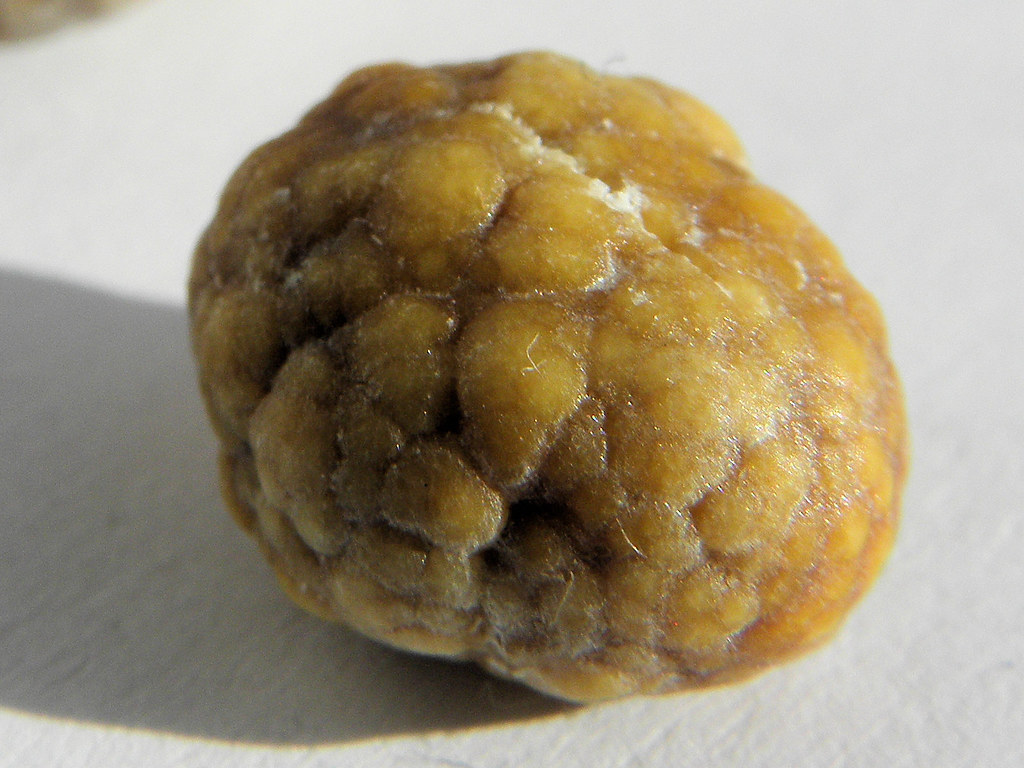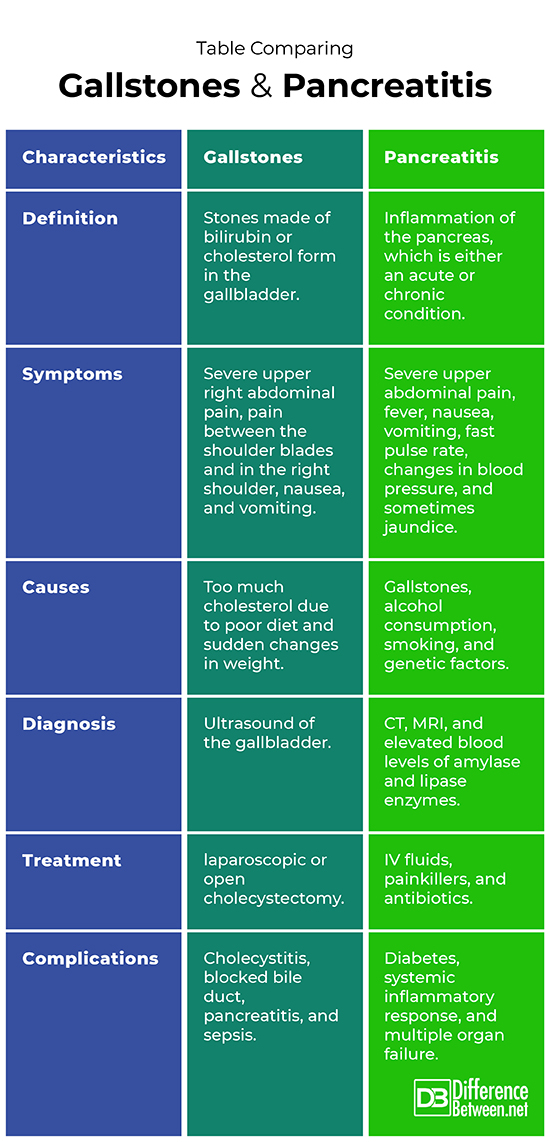Difference Between Gallstones and Pancreatitis
Gallstones are stones made of bilirubin or cholesterol deposits. Pancreatitis is an inflammatory condition of the pancreas.

What is Gallstones
Definition:
Gallstones are hard stones made of cholesterol or bilirubin that form in the gallbladder. The medical term for having gallstones is cholelithiasis.
Symptoms:
For some people there may be no symptoms, but for others, a stone can get stuck causing cholecystitis (inflammation of the gallbladder). Gallstones can temporarily get stuck in the cystic duct causing biliary colic in which the person feels pain in the upper right abdomen, which is alleviated when the stone passes. However, a stone that is stuck and does not pass, can quickly lead to severe upper right abdominal pain, pain between the shoulder blades, bloating, gas, nausea, and vomiting.
Causes and risk factors:
Gallstones are mainly due to eating unhealthy food high in cholesterol, but can occur due to sudden weight loss, or if a person has a liver or blood disorder. Risk factors include being female, being overweight, and being older than 40 years of age. Birth control and hormone replacement medications also increase the risk of gallstones.
Diagnosis:
A physical exam suggestive of gallstones often leads a doctor to suggest an ultrasound. The ultrasound can check for gallstones in the gallbladder.
Treatment:
Most often doctors recommend laparoscopic cholecystectomy in which the gallbladder is removed through a set of small incisions made in the skin. In some cases, open cholecystectomy may be needed, which is more invasive and requires a large incision to be made.
Complications:
Complications of gallstones include cholecystitis, blockage of the bile duct, cancer of the gallbladder, and blockage of the pancreatic duct. Infection can set in when a duct is blocked, increasing the risk of infection and sepsis.

What is Pancreatitis?
Definition:
Pancreatitis is an inflammation of the pancreas. It can be a chronic or acute condition.
Symptoms:
The main symptom is severe abdominal pain that half of all patients feel radiating through to their back. Where the cause is gallstones, the pain onset is very sudden, nausea and vomiting are present, as is fever. The patient with acute pancreatitis appears very ill, pulse rate increases up to 140 beats/minute, there are changes in blood pressure, and sometimes jaundice is evident.
Causes and risk factors:
The cause of acute pancreatitis is drinking alcohol, or even having gallstones. This is because gallstones can sometimes block the pancreatic duct causing problems. There are certain genetic mutations, such as the gene for cystic fibrosis, that can also increase the risk of pancreatitis. Other risk factors include drinking large quantities of alcohol, being obese, and having a family history of the condition. Drinking alcohol when combined with smoking, further increases the risk of pancreatitis
Diagnosis:
Diagnosis is based on imaging studies and blood tests indicating high levels of the enzymes, amylase and lipase (both greater than 200 units per liter of blood). Imaging studies can include CT scans and MRI, the MRI is useful where CT does not give a clear enough picture of the pancreas.
Treatment:
Treatment of pancreatitis is supportive with patients given intravenous fluids and nutrition. Analgesics are given for the severe pain that accompanies the condition. Antibiotic therapy may be indicated where patients show signs of infection.
Complications:
Pseudocysts in which fluid collects around the pancreas can lead to bacterial infections that can be deadly. Other complications include developing diabetes, and systemic inflammatory responses leading to multiple organ failure and death.
Difference between Gallstones and Pancreatitis?
Definition
Gallstones is when stones made of bilirubin or cholesterol form in the gallbladder. Pancreatitis is either short-term or long-term inflammation of the pancreas.
Symptoms
The symptoms of gallstones range from no pain or discomfort to severe upper right abdominal pain, pain between the shoulder blades and in the right shoulder, nausea and vomiting. The symptoms of pancreatitis are severe upper abdominal pain, fever, nausea, vomiting, fast pulse rate, changes in blood pressure, and sometimes jaundice.
Causes
The causes of gallstones include losing weight suddenly and having too much cholesterol in the body, which can be partly due to following an unhealthy diet. The causes of pancreatitis are usually gallstones or drinking alcohol.
Diagnosis
Diagnosis of gallstones is best achieved by ultrasound in which the gallbladder is examined. Diagnosis of pancreatitis is by imaging such as CT scans or MRI scans, and by blood tests that show unusually high levels of the enzyme amylase and lipase.
Treatment
A laparoscopic or open cholecystectomy is recommended if a person has gallstones, especially where the stones are causing problems. Treatment for pancreatitis is more of a supportive nature, with the person being administered IV fluids and nutrients, and given analgesics for pain and, sometimes, antibiotics.
Complications
Complications of gallstones include the following: cholecystitis, blocked bile duct, pancreatitis, and sepsis. Complications of pancreatitis include the following: diabetes, systemic inflammatory response, and multiple organ failure.
Table comparing Gallstones and Pancreatitis

Summary of Gallstones Vs. Pancreatitis
- Both gallstones and pancreatitis can cause abdominal pain that can be very severe.
- Gallstones are related to pancreatitis in that they can cause the pancreas to become inflamed if a stone gets stuck in the pancreatic duct.
- Gallstones can lead to complications including sepsis.
- Pancreatitis can lead to diabetes or multiple organ failure.
- Difference Between Rumination and Regurgitation - June 13, 2024
- Difference Between Pyelectasis and Hydronephrosis - June 4, 2024
- Difference Between Cellulitis and Erysipelas - June 1, 2024
Search DifferenceBetween.net :
Leave a Response
References :
[0]Bartel, Michael. “Acute Pancreatitis” Merckmanuals. Merck & Co., 2020https://www.merckmanuals.com/en-ca/professional/gastrointestinal-disorders/pancreatitis/acute-pancreatitis?query=pancreatitis
[1]Lindenmeyer, Christina. “ Cholelithiasis.” Merckmanuals. Merck & Co., 2020 https://www.merckmanuals.com/en-ca/professional/hepatic-and-biliary-disorders/gallbladder-and-bile-duct-disorders/cholelithiasis?query=Gallstones
[2]Mayo Clinic. “Gallstones.” Mayo Clinic. Mayo Clinic, 2021, https://www.mayoclinic.org/diseases-conditions/gallstones/symptoms-causes/syc-20354214
[3]Image credit: https://upload.wikimedia.org/wikipedia/commons/d/dd/3D_Medical_Animation_Acute_Pancreatitis.jpg
[4]Image credit: https://live.staticflickr.com/6053/6878350010_55c39a5ddc_b.jpg
